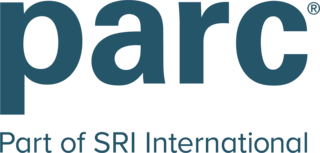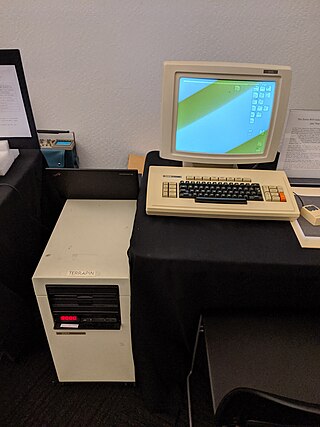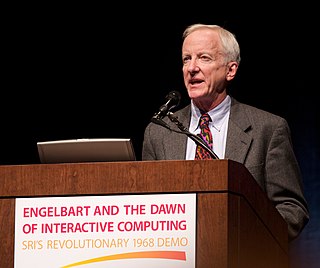Related Research Articles

Lisp machines are general-purpose computers designed to efficiently run Lisp as their main software and programming language, usually via hardware support. They are an example of a high-level language computer architecture. In a sense, they were the first commercial single-user workstations. Despite being modest in number Lisp machines commercially pioneered many now-commonplace technologies, including effective garbage collection, laser printing, windowing systems, computer mice, high-resolution bit-mapped raster graphics, computer graphic rendering, and networking innovations such as Chaosnet. Several firms built and sold Lisp machines in the 1980s: Symbolics, Lisp Machines Incorporated, Texas Instruments, and Xerox. The operating systems were written in Lisp Machine Lisp, Interlisp (Xerox), and later partly in Common Lisp.

SRI Future Concepts Division is a research and development company in Palo Alto, California. It was founded in 1969 by Jacob E. "Jack" Goldman, chief scientist of Xerox Corporation, as a division of Xerox, tasked with creating computer technology-related products and hardware systems.

Xerox Holdings Corporation is an American corporation that sells print and digital document products and services in more than 160 countries. Xerox is headquartered in Norwalk, Connecticut, though it is incorporated in New York with its largest population of employees based around Rochester, New York, the area in which the company was founded. The company purchased Affiliated Computer Services for $6.4 billion in early 2010. As a large developed company, it is consistently placed in the list of Fortune 500 companies.
Xerox Network Systems (XNS) is a computer networking protocol suite developed by Xerox within the Xerox Network Systems Architecture. It provided general purpose network communications, internetwork routing and packet delivery, and higher level functions such as a reliable stream, and remote procedure calls. XNS predated and influenced the development of the Open Systems Interconnection (OSI) networking model, and was very influential in local area networking designs during the 1980s.

Laser printing is an electrostatic digital printing process. It produces high-quality text and graphics by repeatedly passing a laser beam back and forth over a negatively charged cylinder called a "drum" to define a differentially charged image. The drum then selectively collects electrically charged powdered ink (toner), and transfers the image to paper, which is then heated to permanently fuse the text, imagery, or both, to the paper. As with digital photocopiers, laser printers employ a xerographic printing process. Laser printing differs from traditional xerography as implemented in analog photocopiers in that in the latter, the image is formed by reflecting light off an existing document onto the exposed drum.

The Xerox Alto is a computer system developed at Xerox PARC in the 1970s. It is considered one of the first workstations or personal computers, and its development pioneered many aspects of modern computing. It features a graphical user interface (GUI), a mouse, Ethernet networking, and the ability to run multiple applications simultaneously. It is one of the first computers to use a WYSIWYG text editor and has a bit-mapped display. The Alto did not succeed commercially, but it had a significant influence on the development of future computer systems.

The Xerox Star workstation, officially named Xerox 8010 Information System, is the first commercial personal computer to incorporate technologies that have since become standard in personal computers, including a bitmapped display, a window-based graphical user interface, icons, folders, mouse (two-button), Ethernet networking, file servers, print servers, and email.
Interlisp is a programming environment built around a version of the programming language Lisp. Interlisp development began in 1966 at Bolt, Beranek and Newman in Cambridge, Massachusetts with Lisp implemented for the Digital Equipment Corporation (DEC) PDP-1 computer by Danny Bobrow and D. L. Murphy. In 1970, Alice K. Hartley implemented BBN LISP, which ran on PDP-10 machines running the operating system TENEX. In 1973, when Danny Bobrow, Warren Teitelman and Ronald Kaplan moved from BBN to the Xerox Palo Alto Research Center (PARC), it was renamed Interlisp. Interlisp became a popular Lisp development tool for artificial intelligence (AI) researchers at Stanford University and elsewhere in the community of the Defense Advanced Research Projects Agency (DARPA). Interlisp was notable for integrating interactive development tools into an integrated development environment (IDE), such as a debugger, an automatic correction tool for simple errors, and analysis tools.

Robert William Taylor, known as Bob Taylor, was an American Internet pioneer, who led teams that made major contributions to the personal computer, and other related technologies. He was director of ARPA's Information Processing Techniques Office from 1965 through 1969, founder and later manager of Xerox PARC's Computer Science Laboratory from 1970 through 1983, and founder and manager of Digital Equipment Corporation's Systems Research Center until 1996.
George E. Pake was a physicist and research executive primarily known for helping found Xerox PARC.

Charles Patrick "Chuck" Thacker was an American pioneer computer designer. He designed the Xerox Alto, which is the first computer that used a mouse-driven graphical user interface (GUI).

Robert Fletcher "Bob" Sproull is an American computer scientist, who worked for Oracle Corporation where he was director of Oracle Labs in Burlington, Massachusetts. He is currently an adjunct professor at the College of Information and Computer Sciences, at the University of Massachusetts Amherst.

Richard "Dick" Francis Lyon is an American inventor, scientist, and engineer. He is one of the two people who independently invented the first optical mouse devices in 1980. He has worked in signal processing and was a co-founder of Foveon, Inc., a digital camera and image sensor company.

Gary Keith Starkweather was an American engineer who invented the laser printer and color management.
The Stanford University Network, also known as SUN, SUNet or SU-Net is the campus computer network for Stanford University.
Abbey Silverstone is an early executive in the computer industry. He co-founded Silicon Graphics (SGI) with Jim Clark, and was its first Vice President of Operations until 1989.

The IBM 3800 is a discontinued laser printer designed and manufactured by IBM. It was the first commercially available laser printer. It was a continuous form laser printer, meaning that it printed onto a continuous long sheet of paper.
The Xerox 9700 was a high-end laser printer manufactured by Xerox Corporation beginning in 1977. Based on the Xerox 9200 copier, the 9700 printed at 300 dots-per-inch on cut-sheet paper at up to two pages per second (pps), one- or two-sided, that is simplex or duplex, landscape or portrait.
The Xerox 2700 is a discontinued monochrome laser printer from Xerox Corporation. The 2700 was announced in March, 1982, and can print up to 12 pages per minute (PPM), one-sided, on standard A4 or Letter cut-sheet paper. It occupies 5 square feet (0.46 m2) of floor space, and cost $18,995. The 2700 is rated for a print volume of 15,000 pages per month, although some users got up to 100,000 pages.
References
- 1 2 "Dover Laser Printer". Computer History Museum. 1976. Retrieved 2022-07-15.
- ↑ "Origins & Early Development of Scalable Digital Type Fonts at Xerox PARC". historyofinformation.com. Retrieved 2022-07-15.
- ↑ Pings, Gregory (2017-06-29). "Marking 40 Years of Xerox Laser Printing With Its Inventor Gary Starkweather". Digital Printing Hot Spot. Retrieved 2022-07-15.
- ↑ "Collection of Dover printer documentation" (PDF). bitsavers.org.
- ↑ "Welcome to Alto Land: Stanford Alto User's Manual" (PDF). bitsavers.org. September 1980. Retrieved 2022-07-15.
- ↑ Stacy, Christopher C. (7 September 1982). "Getting Started Computing at the Al Lab" (PDF). MIT Dspace. Massachusetts Institute of Technology. Retrieved 2021-08-20.